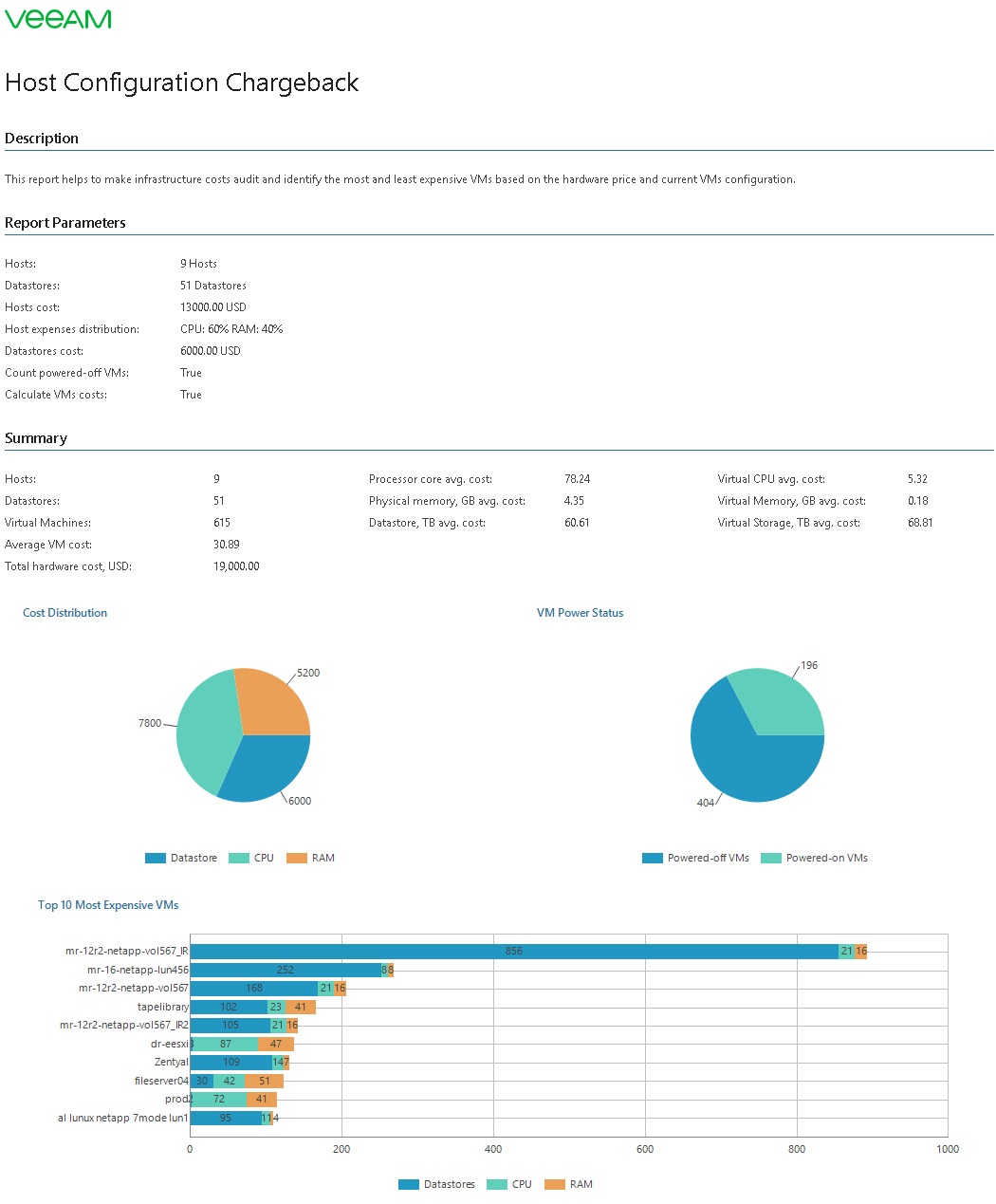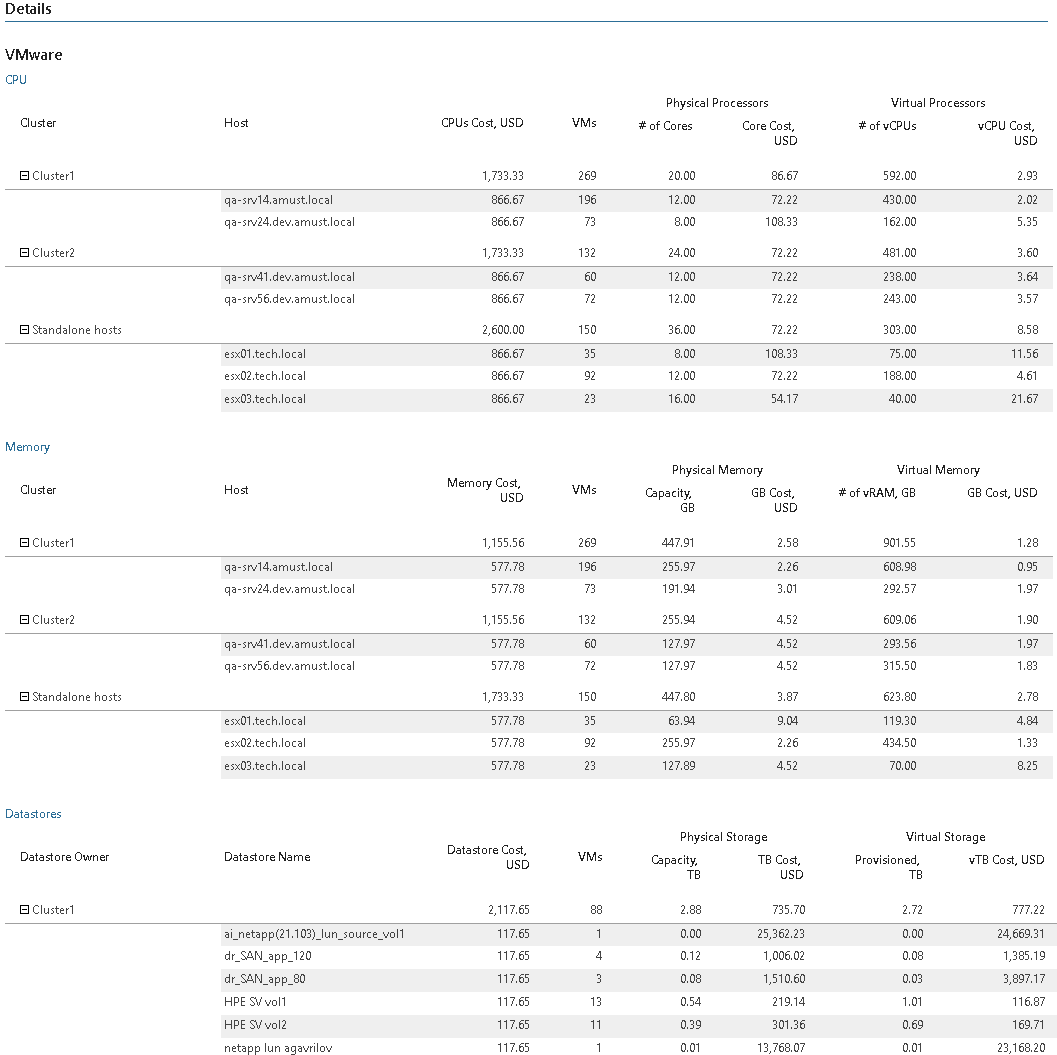 This is an archive version of the document. To get the most up-to-date information, see the current version.
This is an archive version of the document. To get the most up-to-date information, see the current version.Host Configuration Chargeback
This report helps to make infrastructure costs audit and identify the most and least expensive VMs based on the hardware price and VM configuration.
The report analyzes hardware CPU, memory, storage capacities and their cost to calculate the cost of resources allocated to VMs. The cost of resources allocated to a VM is calculated based on VM configuration: the amount of vCPU, vRAM and storage resources provisioned to a VM.
The Summary section includes the following elements:
- Number of hosts, datastores and VMs, average costs of physical and virtual resources (processor core, virtual CPU, memory GB, storage TB), and total hardware cost.
- The Cost Distribution chart shows the cost of hardware CPU, memory and storage resources.
- The VM Power Status chart shows the number of running and powered-off VMs.
The Details tables provide information on physical CPU, memory and storage capacities, amount of provisioned vCPU, vRAM and storage resources, and the cost of these resources. If you choose to calculate VM cost in the report parameters, the report also provides analysis of VM configuration cost in terms of vCPU, vRAM, storage and the total VM cost.
Report Parameters
You can specify the following report parameters:
- Currency: defines a payment currency.
- Hosts: defines the list of hosts to analyze in the report.
- Calculate based on the total hosts cost: defines the total cost of CPU and memory hardware resources for all hosts included in the report, in the selected currency.
If you do not select the Calculate based on the total hosts cost check box, you must specify the hardware cost of each host separately. To do this, in the Actions pane on the right click Hosts. In the Set hardware costs window, specify the hardware cost for each separate host in the selected currency.
- CPU: defines the percentage of cost, or cost share of CPU hardware resources for all hosts included in the report. For example, if the cost of CPU hardware resources make a quarter of the total cost, specify 25 as the parameter value.
- RAM: defines the percentage of cost, or cost share of memory hardware resources for all hosts included in the report. For example, if the cost of memory hardware resources make three quarters of the total cost, specify 75 as the parameter value.
|
The sum of CPU and RAM percentage values must be equal to 100. |
- Include datastores cost:defines whether the report must include datastores cost details.
- Calculate based on the total datastore cost: defines the total cost of storage resources in the selected currency.
If you do not select the Calculate based on the total datastore cost check box, you must specify the cost of each datastore separately. To do this, in the Actions pane on the right click Datastores. In the Set hardware costs window, specify the cost of each separate datastore in the selected currency.
- Count powered-off VMs: defines whether powered-off VMs must be analyzed in the report.
- Calculate VMs costs: defines whether the report must include VM cost details.
If th is option is enabled, the report will include the Top 10 Most Expensive VMs section and a table that details VMs cost based on VM configuration.
|
Building the report may take some time if the chosen reporting period is significant, or if you choose to calculate VM cost for a large virtual infrastructure. |
Use Case
IT departments can use the report as a showback instrument to raise awareness within organization and demonstrate costs associated with provisioning VMs. The report helps calculate a budget share of allocated virtual infrastructure resources for each application owner, department or business unit within an organization, justify IT budget and assess the amount of future funding requests.
In combination with Veeam ONE optimization reports, this report can be used to encourage application owners to right size their VMs, prevent VM proliferation and reclaim wasted resources.
Service providers that do not have flat fees on virtual infrastructure resources can use this report as a chargeback instrument to calculate the cost of virtual infrastructure resources allocated to their clients.
Notes
When analyzing report data, note the following:
- For VMs with thin-provisioned or dynamic disks, the report takes into account the amount of provisioned disk space, not actually used disk space.
- For VMs with dynamic memory, the report takes into account the amount of allocated memory.


